We had a programmed ‘acclimatisation day’ at Namche and another at Dingboche. Tully had decided we would use these days to climb up to the next 500 metre ‘step’ and then descend again to sleep. This proved to be a good preventative for altitude sickness as was taking half a Diamox twice a day starting on the morning you are to leave Kathmandu. An acclimatisation day spent wandering the hills around Lukla is also a good idea.
Some views of the Namche ‘Skyway’:
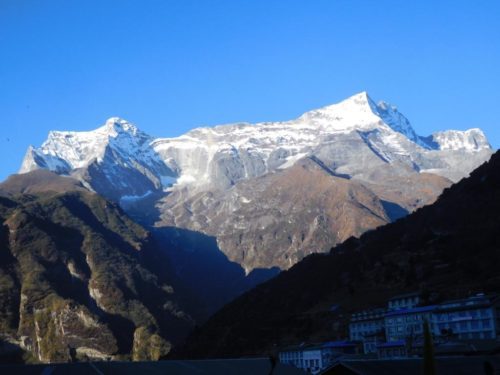
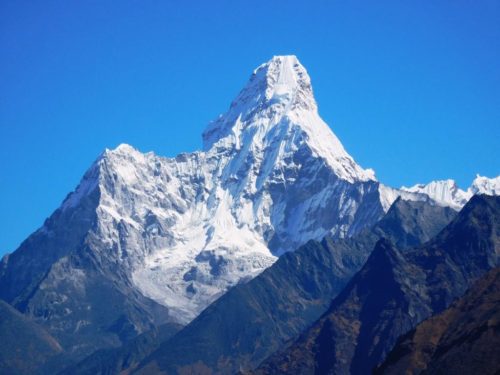
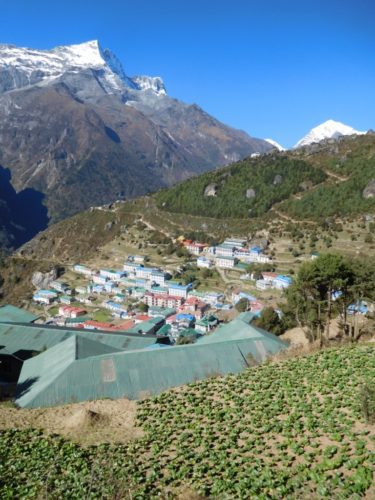
Leaving Namche
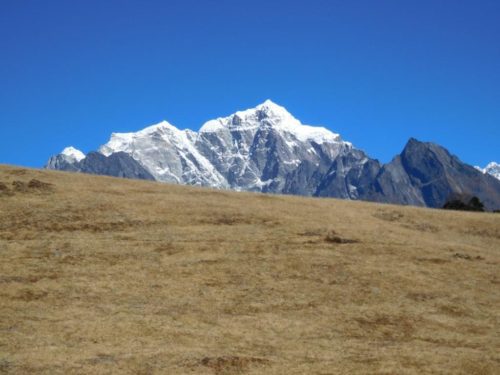
Walking ‘across the top’ to the ‘Everest View’ Hotel:
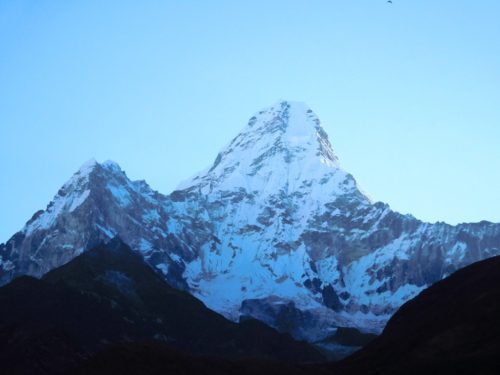
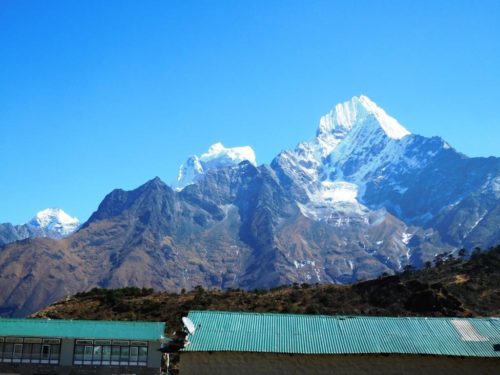
A number of trekkers told me that the track up from Jiri to Lukla is the best and most beautiful part of the trail and that there are very few people on it. What a bonus! I suspect this is true. If I had my time again I would probably have walked from Jiri and flown out from Lukla, but after fighting with this terrible lung infection for a month now I doubt I will be eager to retrace my footsteps in Nepal!
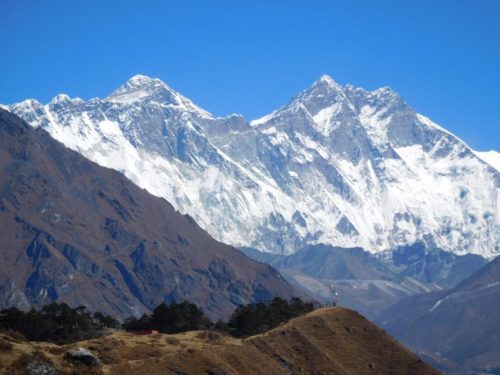
Gazing up the valley towards Everest (right of centre).
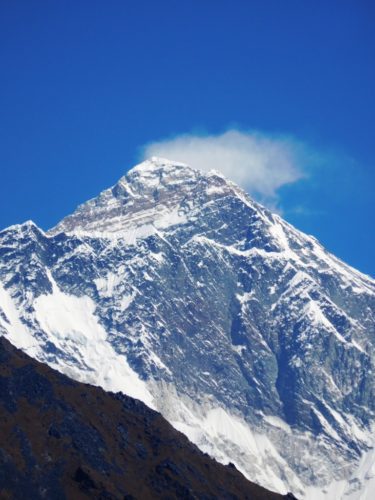
Everest View.
Thus we ascended from Namche to the eponymous ‘Everest View’ Hotel, (a facsimile of Douglas Adams’ ‘The Hotel at the End of the Universe’ – and peopled identically!), then circled back through the prosperous potato towns of Khumjung and Kunde. ‘Green Towns’ a Sherpa told me, presumably because of the ‘Colorbond’ rooves. In Khumjung we sampled our first ‘Garlic Soup’ and found it good!
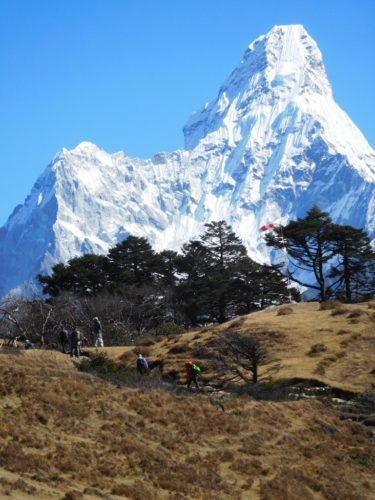
Another view ‘across the top’ to the ‘Everest View’ Hotel.
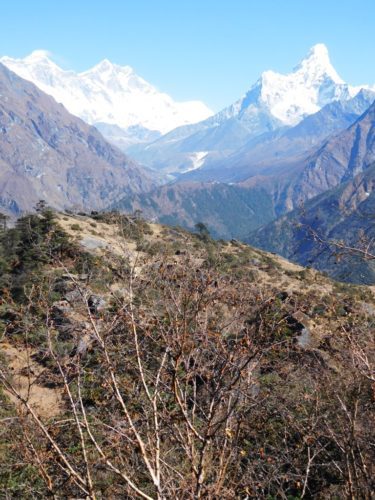
View up the valley from the ‘Everest View’ Hotel. Tengboche is atop that green hill centre.
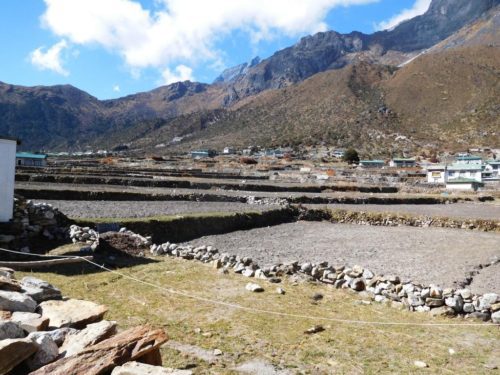
Khumjung – a ‘Green Town’.
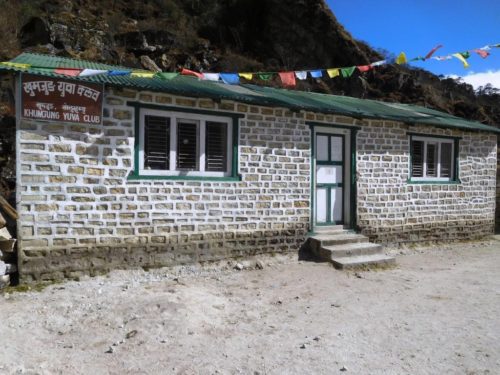
Interesting stone building outside the ‘Hilary School. Netball seems enormously popular.
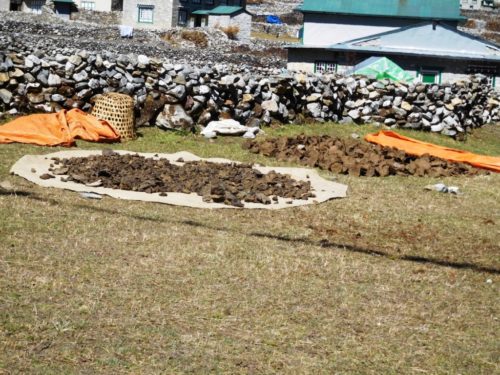
The practice of burning (yak) dung must deplete the nutrients of their fields.
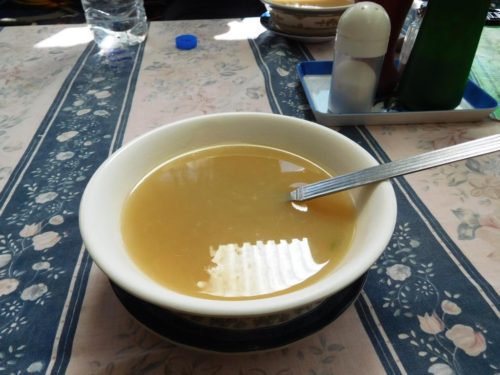
The eponymous ‘garlic Soup’, Khumjung version. Cafe opposite the ‘Hilary School’.
Someone (I will not mention who!) took a wrong turn at Syanboche on the descent (the turn-off being temporarily obscured by a camel, fit of coughing, lapse of intelligence, or etc) and ended up nearly all the way to Thame before he found a cattle pad or game trail which would allow him to descend into Namche just on dusk. A good thing he has well-honed wilderness skills!
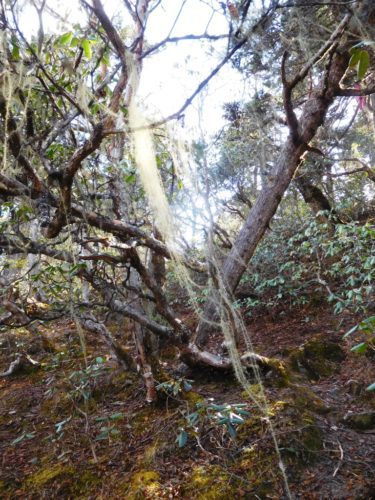
Coming down from Kunde there was some attractive vegetation.
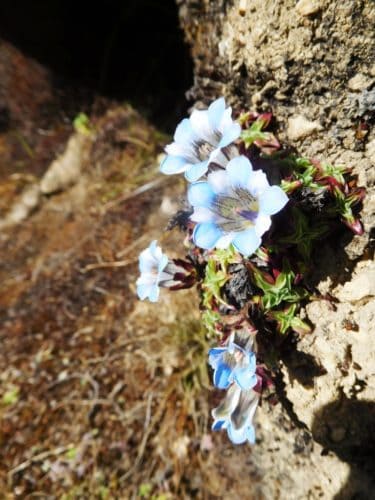
Even some pretty flowers.
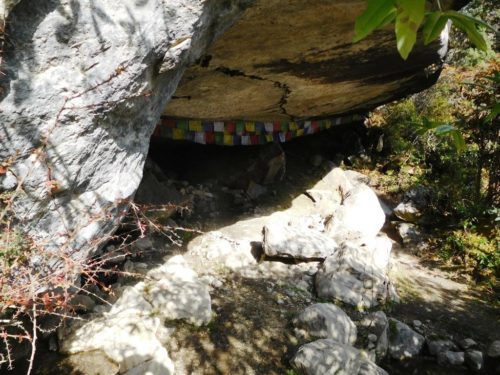
Porters have to bear some pretty primitive accommodation – this cave on the road from Thame to Namche.
A guide or porter might help prevent such mishaps, but I encountered many such with zero English language skills. Too often they rushed ahead of their ‘guests’ forcing the pace dangerously in the low oxygen environment. In my experience they were almost universally completely unable to understand or answer any question in English, though I asked many.
For example, I was curious (at the higher altitudes) to learn when the Sherpa first ventured there – as there were no abandoned ruins at higher points which might indicate they had colonised them during the medieval warm period. None knew – or understood! Those who forget their past are destined to repeat it! The answer is clearly that they have only inhabited these regions relatively recently- ie the last 500 years or so
On my ‘trail of tears’ pneumonic return journey I staggered along with a middle aged Norwegian nurse (Lise) for two days. She had been abandoned by her entire party, including her personal guide and two porters. She was nearly as sick as I (or sicker) and also had limited English skills, but we were thankfully able to help each other, despite her being an avowed feminist (to which I replied, ‘How sad’) and my being, as I’m sure you know, a shocking misogynist who would never help a woman!
However I grew up with the tradition of the ‘Birkenhead’ to inspire me. There was so much that was great about the old Empire. Nepal (and Tibet) must sorely regret they rejected it when they once had the opportunity to welcome its blessings with open arms!
If you do not have years of wilderness experience such as I do, you might be better to venture out with a group, guides, porters etc. I prefer the dignity of carrying all my own gear – and being self-sufficient no matter what happens to me. So, for example, I carried my Delorme Inreach SE PLB http://www.theultralighthiker.com/the-poor-mans-satellite-phone/ whilst Tully carried my Sat Phone – in case of real emergencies, and if we were separated. Sound practice – as it turned out! I had my Escape Bivy and My Thermorest Neoair Women’s mat, my re-engineered sleeping bag (good to -30C http://www.theultralighthiker.com/adding-down-to-a-sleeping-bag/), and lots of warm Montbell clothes (http://www.theultralighthiker.com/?s=montbell in case I had accidentally to spend a night stuck high in the snowy passes.
I even had with me my trusty Vango 450 ml cup, a titanium windscreen and an 11 gram Esbit stove in case I wanted a hot cup of Mocca on some icy mountaintop! I also had a second (and third) tranche of antibiotics in case the first (Cipro) did no good – it got me back! The second and third are yet doing battle with this dreadful lurgi. I still have no idea whether I will survive it. Some days it has the upper hand, other days I forge ahead of it. Five crises so far! Life is ever a race to the grave which you one day lose.
I am a pessimist by preparation, not by nature. I know that the larger parties were not nearly so well prepared, which would mean only that people would die en masse (as they did on the Annapurna circuit a couple of years back http://www.theultralighthiker.com/survival-shelter/) rather than alone – or not at all.
It is akin to the spurious ’safety’ such folks feel in crowds – vowing eg that cities are safer than the wilderness, imagining ‘Wolf Creek/Deliverance’ dangers lurking behind every rock, whilst ignoring the nuclear missiles aimed squarely at their cherished megapolises! Strangely though, such folks had porters to carry their gear, nonetheless they all had day packs clearly weighing more than my pack – which contained all my gear. Their sheer superfluity overwhelms my sense of wonder at their vapidity
I was appalled at how some (foreigners) treated their ‘servants’. Often I witnessed folks making what I (having grown up in an egalitarian culture) considered outrageous demands of them. For example, one person waited until his guide sat down to his own meal before demanding a bottle of water (which was in his own reach in his pack pocket). The Sherpa patiently rose and fetched it for him. When he was seated once more, his ‘master’ then demanded that he open it! The Sherpa once more patiently rose and did so. I fear one day the Sherpas may rise against such treatment in greater earnest; some of them at least are Ghurkas, remember. They appear to be the most pleasant and friendly people imaginable though.
We stayed in Namche for three days altogether, two on the way up; one on the way back. We found the Shangri La Lodge (just off to the East of the main street a block above the pharmacies) quite pleasant and the food good. A lot of local people ate there – which is no doubt a good sign!
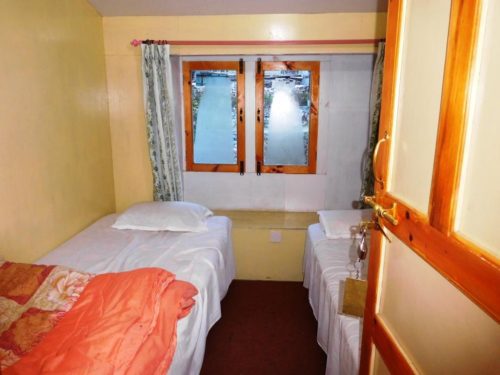
The rooms were clean and comfy, a toilet close by – and a welcome hot shower downstairs.
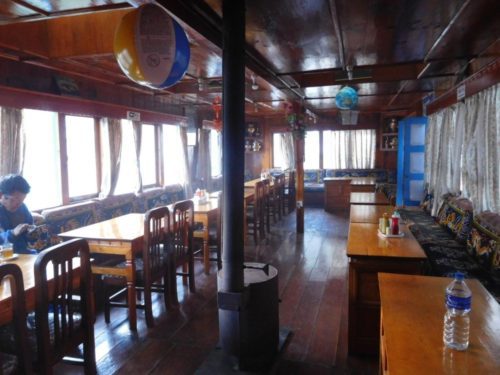
Warm dining room.
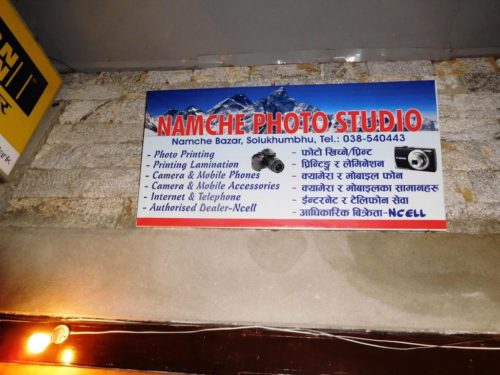
This business in Namche (there are dozens of shops) was really good at fixing phones/photographic equipment etc, else I would not have been able to contact my wife (to arrange my rescue for example!).
After Namche you follow the river high on its true right bank the first few hours past a monument to Tensing, one of the first two men on top of Everest – at least if Mallory and Irvine’s camera never emerges from the ice atop the mountain. (Interestingly the Sherpas had not yet been enlisted into mountain climbing in the 1920s when Mallory perhaps stood on Everest).
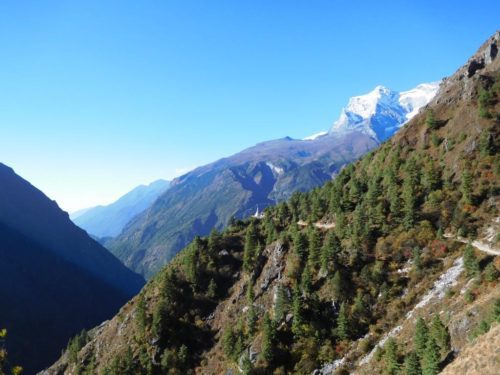
Looking back down the valley towards Namche hidden behind Tensing’s chorten behind the hill (right)

Tensing’s chorten.
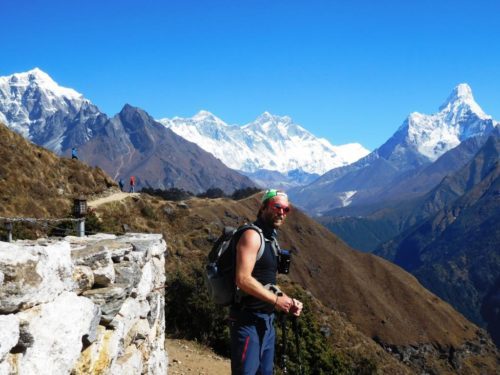
View up the river from Tensing’s chorten. Tully posing.
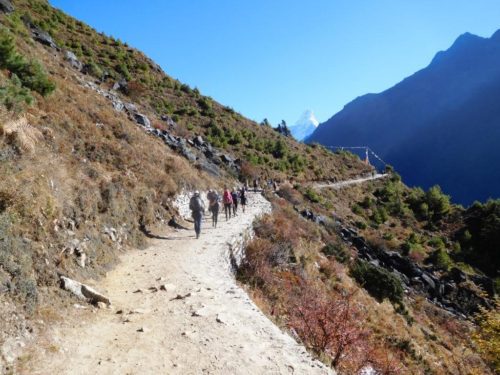
Crowds of folk flowing towards Everest.
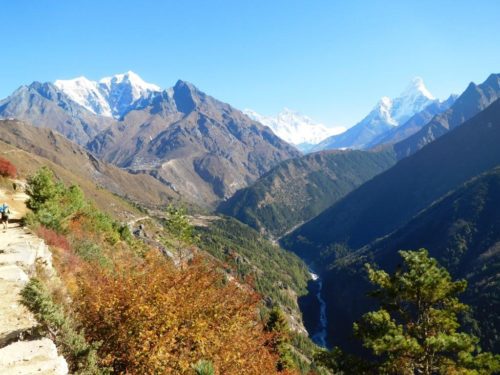
View up the river. Tengboche is atop the green ‘hill’ centre.
The track goes along on the level for quite a distance, this section well maintained by the collections of an old man who has climbed Everest five times. You descend 300 metres to yet another river crossing sheltering a pleasant little town complete with its ubiquitous military outpost. (You soon get used to the level of fascism in Nepal – no doubt so long as you are not a member of the Royal Family or such it should cause no disquiet!) We enjoyed a pleasant lunch at a café just before the bridge.

Some lovely villages along the way. Each has its tea house/s and gift shops.

Lunch at the bridge.
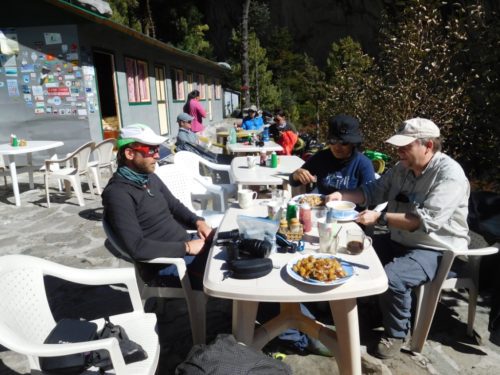
As you can see i am having the ‘Vegetable fried Potatoes’ We stuck to vegetarian food after Pangboche – no fresh meat.
There follows a long (but pleasant) climb up a beautifully wooded hill complete with delightful skyline views to the monastic town of Tengboche – where you used to be able to fondle a Yeti’s skull – till someone stole it! Tengboche has a tasty bakery where you can enjoy a delightful lunch complete with views of frozen waterfalls on the surrounding hills & etc. We had afternoon teas here: biscuits, doughnuts, buttered sweet rolls, etc and of course the ubiquitous lemon tea.
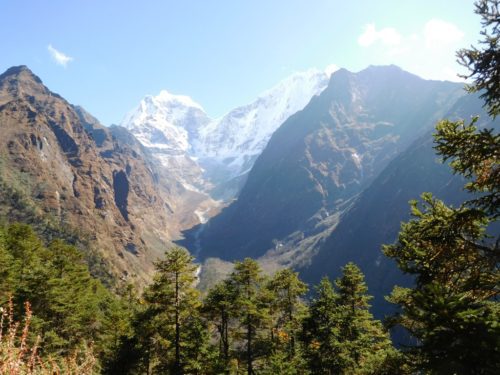
View to the east as you climb the Tengboche hill.
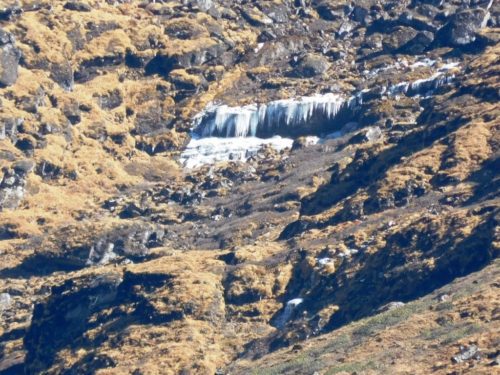
You can ogle frozen waterfalls as you sip your latte and devour your croissants – who could ask for more?
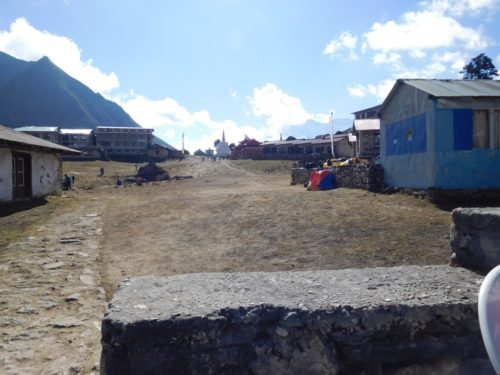
Main Street Tengboche.
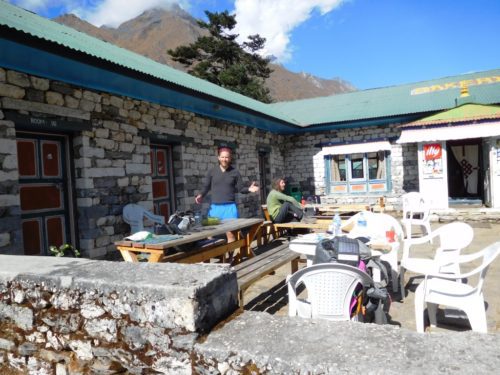
Bakery Tengboche.
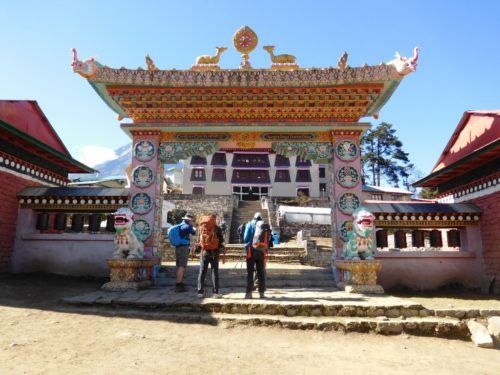
This religious gibberish is ubiquitous in Nepal: the Tengboche Monastery.
After Tengboche there follows another reasonable descent again through some quite pretty forest to Duboche (the bridge across the river there marks the end of the forest). In Duboche is a pretty tea-house named ‘Rivendell’ framed by a beautiful view – somewhat spoiled by the 3 metre high barbed wire fence around it. Just a little repellent if it expects numerous customers – or perhaps you ought not want to leave?
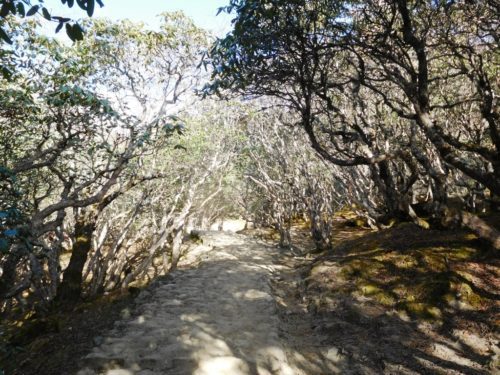
Descending through rhododendron forests.
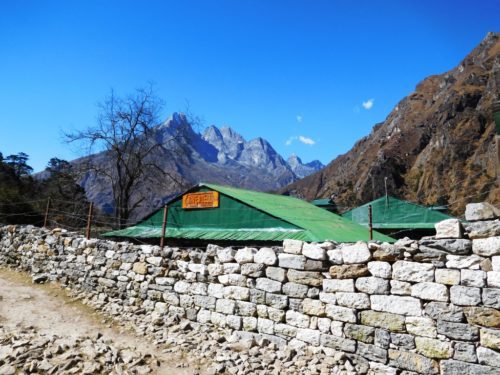
A forbidding ‘Rivendell’.
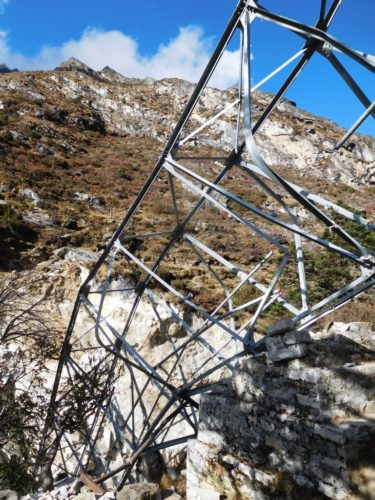
This bridge was well broken.
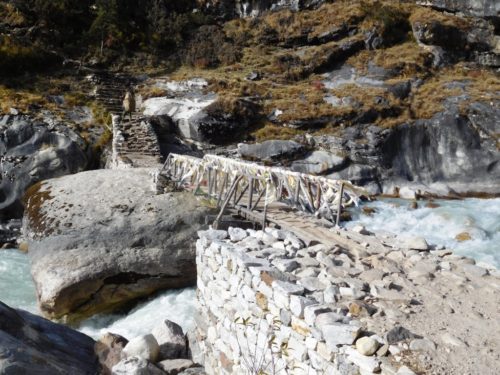
And its replacement somewhat rickety.
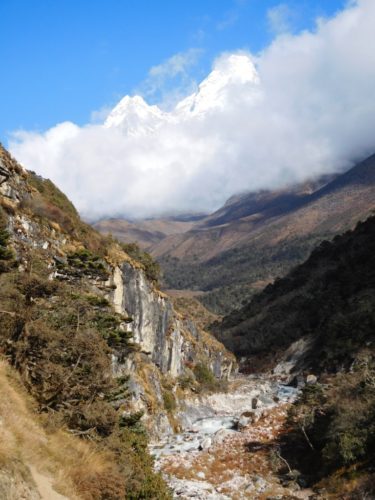
View upriver from the bridge.
After Duboche the bridge had been washed out and an interesting temporary bridge crafted to replace it. Because there is a detour after the bridge you might lose your way and head back downstream to where the old bridge crossed unless you remember that Pangboche is upstream on the true right bank, so that all you need to do is scramble up the yak tracks to the old path to continue your journey.
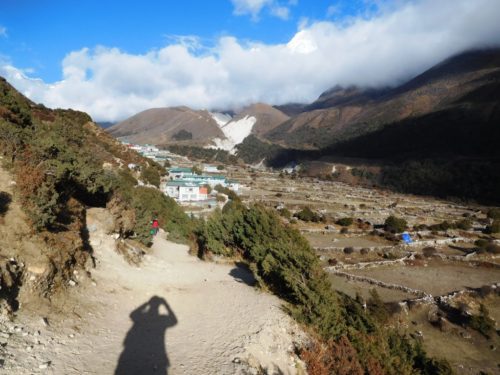
First view of Pangboche- a potato town.
As soon as you cross the river you are in quite a different type of low, straggly vegetation which I at first thought marked the treeline until I spied a seedling pine/cypress just poking above a patch of well-gnawed shrubbery. Clearly the yaks have been very busy on the forests hereabouts; maybe also the banished goats.
An easy climb (and descent) brings you to the potato town of Pangboche where we spent the night (on a guide’s recommendation) at the Mountain Peace Lodge which actually charged nothing for accommodation (the usual price is $US1-2 per night so long as you eat in), and which had an excellent hot shower (which always cost more than the accommodation – $US3-5). The host was a very friendly, entertaining chap with whom we spent many hours yarning. His ‘wealth’ had been founded on his owning an adjoining ¼ hectare potato ‘farm’ We tourists were clearly of immense benefit to him.
That night there was a beautiful sunset (and dawn) somewhat obscured by clouds/mist, though it had Tully scrambling around in the dark and cold trying to get that perfect photograph. The Young! The mountains surrounding the towns of Dingboche and Pangboche are quite awesome.

Quite startling – Everest is up there somewhere!
See also:
http://www.theultralighthiker.com/to-the-roof-of-the-world/
http://www.theultralighthiker.com/i-followed-my-footsteps/
http://www.theultralighthiker.com/i-saw-below-me-that-golden-valley/
http://www.theultralighthiker.com/thatendlessskyway/
http://www.theultralighthiker.com/everest-base-camp-three-passes-trek/
http://www.theultralighthiker.com/cold-weather-face-masks/
http://www.theultralighthiker.com/my-life-was-wide-and-wild-and-who-can-know-my-heart/

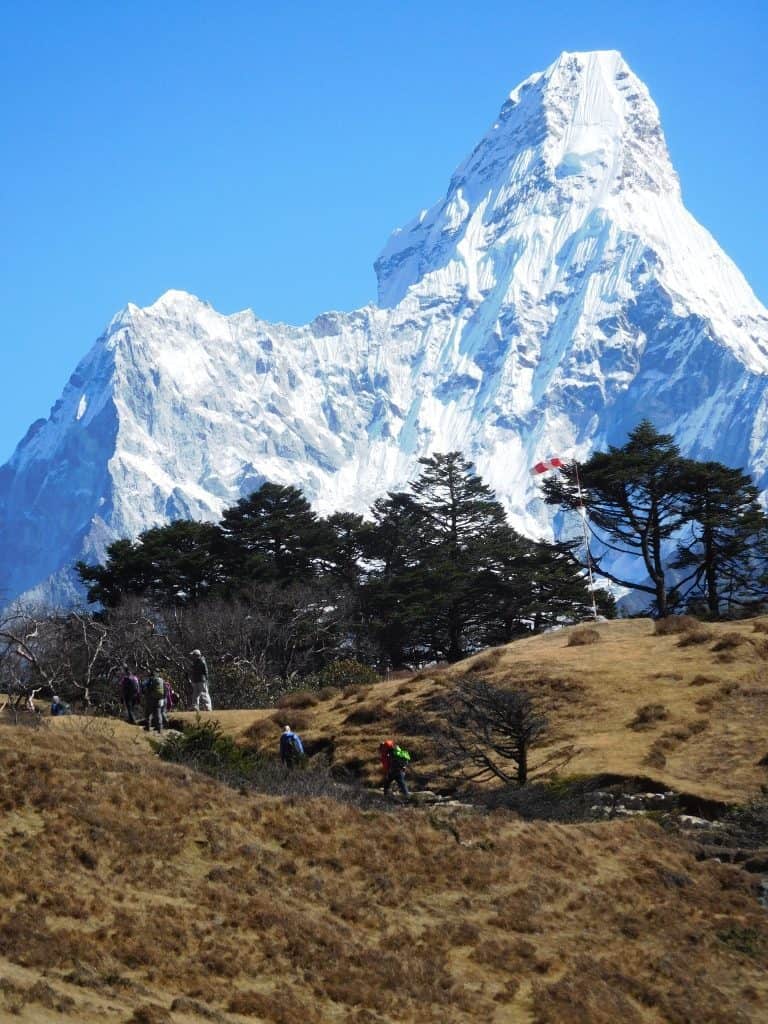
I wish to know more about the Condor burial rites.
We will have to return again to invetsigate them!